Wafer processing base
- Summary
- Abstract
- Description
- Claims
- Application Information
AI Technical Summary
Benefits of technology
Problems solved by technology
Method used
Image
Examples
preparation example 1
Preparation of Partially Polymerized Product (A1)
[0067]A monomer mixture of 60 parts by weight of 2-ethylhexyl acrylate (2-EHA), 35 parts by weight of isobornyl acrylate (IBOA) and 5 parts by weight of acrylic acid (AA) was input into a 1 L reactor containing refluxed nitrogen gas and a cooling apparatus for easy control of the temperature. The nitrogen gas was then purged in order to remove oxygen. Afterwards, the mixture was homogenized while maintaining the temperature at 60° C., and the reaction was initiated by adding 0.015 parts by weight of diethylhexyl peroxydicarbonate as an initiator and 0.08 parts by weight of n-dodecyl mercaptan (n-DDM) as a chain transfer agent so as to prepare a partially-polymerized acrylic syrup having a solid content of 25 wt %, a weight average molecular weight of 400,000 and a glass transition temperature of −21° C. In the above, the weight average molecular weight of the syrup was the weight average molecular weight of the polymer included in the...
preparation example 2
Preparation of Partially Polymerized Product (A2)
[0068]A monomer mixture of 70 parts by weight of 2-ethylhexyl acrylate (2-EHA), 27 parts by weight of isobornyl acrylate (IBOA) and 3 parts by weight of hydroxyethyl acrylate (HEA) was input into a 1 L reactor containing refluxed nitrogen gas and a cooling apparatus for easy control of the temperature. The nitrogen gas was then purged in order to remove oxygen. Afterwards, the mixture was homogenized while maintaining the temperature at 60° C., and the reaction was initiated by adding 0.015 parts by weight of diethylhexyl peroxydicarbonate as an initiator and 0.04 parts by weight of n-dodecyl mercaptan (n-DDM) as a chain transfer agent so as to prepare a partially-polymerized acrylic syrup having a solid content of 35 wt %, a weight average molecular weight of 800,000 and a glass transition temperature of −36° C. In the above, the weight average molecular weight of the syrup was the weight average molecular weight of the polymer inclu...
example 1
[0069]A photo-curable composition was prepared by mixing 30 parts by weight of isobornyl acrylate (IBOA) with 70 parts by weight of the partially polymerized product (A1), adding 1.0 part by weight of 1,6-hexanediol diacrylate as a multi-functional acrylate and 1.0 part by weight of 1-hydroxycyclohexyl phenyl ketone (Igacure 184) as a photoinitiator thereto, and mixing and defoaming the resultant mixture. Afterwards, the resultant composition was coated on a polyester releasing film using a bar coater to a thickness of about 140 μm. Subsequently, to prevent the coated layer from being in contact with oxygen, another polyester releasing film was laminated on the coated layer while UV-A irradiation was performed using a metal halide lamp at a light intensity of 800 mJ / cm2, thereby preparing a photo-cured product (substrate).
PUM
| Property | Measurement | Unit |
|---|---|---|
| Temperature | aaaaa | aaaaa |
| Temperature | aaaaa | aaaaa |
| Temperature | aaaaa | aaaaa |
Abstract
Description
Claims
Application Information
 Login to View More
Login to View More - R&D
- Intellectual Property
- Life Sciences
- Materials
- Tech Scout
- Unparalleled Data Quality
- Higher Quality Content
- 60% Fewer Hallucinations
Browse by: Latest US Patents, China's latest patents, Technical Efficacy Thesaurus, Application Domain, Technology Topic, Popular Technical Reports.
© 2025 PatSnap. All rights reserved.Legal|Privacy policy|Modern Slavery Act Transparency Statement|Sitemap|About US| Contact US: help@patsnap.com


